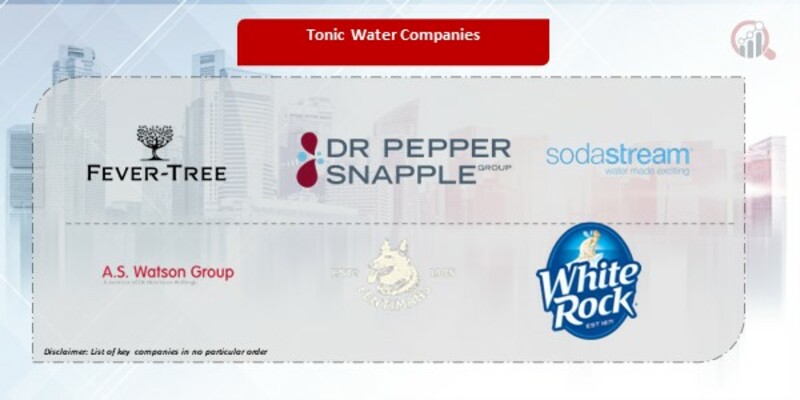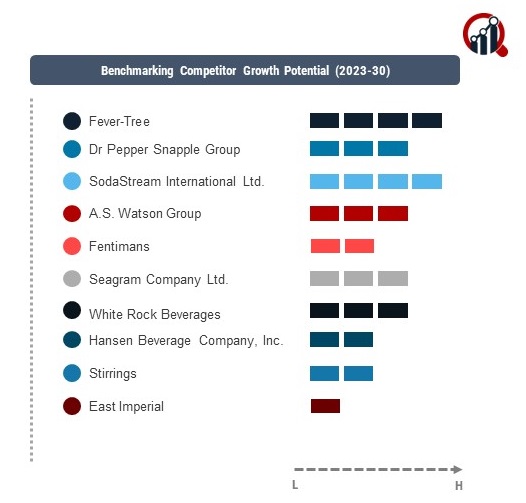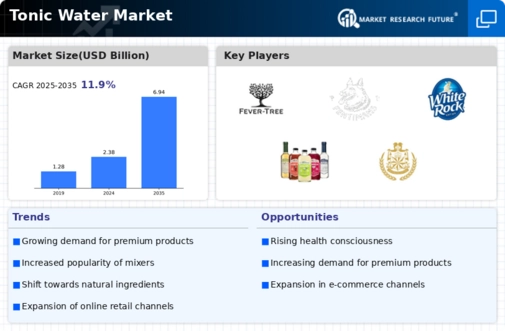Top Industry Leaders in the Tonic Water Market

The Tonic Water market, a notable segment within the global beverage industry, is characterized by a competitive landscape influenced by factors such as the resurgence of interest in premium and craft mixers, the growing popularity of mixology and cocktail culture, and the increasing demand for low-calorie and naturally flavored options. As of 2023, key players strategically position themselves in this competitive environment, implementing various strategies to maintain or enhance their market share.
Strategies Adopted:Key players in the Tonic Water market deploy a range of strategies to remain competitive. Continuous innovation in flavor profiles, natural ingredients, and packaging is a central strategy. Strategic partnerships with bars, restaurants, and spirits brands contribute to promoting the use of their tonic water in premium cocktails. Marketing efforts often focus on brand positioning, highlighting the premium quality, low sugar content, and versatility of their tonic water. Companies also engage in collaborations with mixologists and influencers to create signature cocktail recipes and enhance brand visibility.
Market Share Analysis:Market share analysis in the Tonic Water market is influenced by several factors, including brand recognition, product quality, pricing strategies, and distribution efficiency. Companies with strong brand equity and a reputation for producing high-quality tonic water tend to secure a larger market share. Pricing strategies that balance affordability with perceived value play a crucial role, especially considering the competition with traditional mixers. Effective distribution networks, covering both on-premise channels (bars and restaurants) and off-premise channels (retail), are vital for maintaining a competitive edge.
New and Emerging Companies:While key players dominate the Tonic Water market, new and emerging companies are entering the sector, often focusing on niche markets or introducing unique flavor combinations. These entrants may emphasize natural botanicals, exotic flavors, or target specific consumer preferences, contributing to the overall diversification and innovation in the Tonic Water market. Although their market share may be relatively modest compared to industry leaders, these companies play a role in driving trends and meeting the evolving demands of consumers.
Industry Trends:The Tonic Water market has witnessed noteworthy industry news and investment trends in 2023. Key players are investing in sustainable and eco-friendly packaging solutions, responding to the growing consumer awareness of environmental impact. Collaborations with spirits brands and participation in mixology events contribute to enhancing brand visibility and expanding market reach. Additionally, investments in technology adoption, such as advanced bottling and carbonation systems, aim to improve production efficiency and maintain the carbonation levels in tonic water.
Competitive Scenario:The Tonic Water market is marked by intense rivalry among key players striving to capture a larger share of the growing market. The industry's competitiveness is evident in the emphasis on innovation, sustainability, and strategic collaborations to address evolving consumer preferences. The global reach of these companies enables them to adapt to regional tastes, capitalize on emerging markets, and navigate regulatory landscapes, contributing to the overall dynamism of the industry.
Recent Development:PepsiCo: Introduced SodaStream Sparkling Natural Flavours Tonic Water, offering home soda makers a low-sugar substitute.Coca-Cola: Introduced Cucumber Lime Smartwater Sparkling, a calorie-free, sugar-free tonic water choice with delicate natural flavours.
Key Players:Fever-Tree (UK)Dr. Pepper Snapple Group (US)SodaStream International Ltd. (Israel)A.S. Watson Group (China)Fentimans (UK)Seagram Company Ltd. (Canada)White Rock Beverages (US)Hansen Beverage Company Inc. (US)Stirrings (US)East Imperial (New Zealand)











